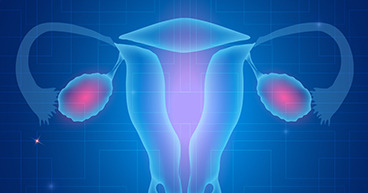
It may be hard to believe today, but in the 1980s, the public knew little about breast cancer, how it forms and how it’s treated. But thanks to annual Breast Cancer Awareness efforts launched every October, when the country is awash in pink ribbons, many women are better informed about how they may reduce their risk for developing the disease, and what they should do to screen for it. But gynecological cancers get little of that public attention. You may not know, for example, that September is Gynecologic Cancer Awareness Month, designed to inform women and their loved ones about the seven main cancers that may develop in a woman’s reproductive system. And yet, these cancers affect tens of thousands of women each year.
Gynecologic cancers, in fact, are fairly common—more than 107,000 women will be diagnosed with one of these diseases in 2017, according to the American Cancer Society. Three of these cancer types—cervical, ovarian/fallopian tube (as well as peritoneal) and endometrial (uterine)—are more common than vaginal and vulvar cancers. Other related cancers include germ cell ovarian cancers, stromal cell ovarian cancer, gestational trophoblastic neoplasia, and uterine sarcoma, all of which are also treated by a gynecologic oncologist.
While they are often discussed as a group, each gynecologic cancer is distinct, with its own symptoms, risk factors and treatments. “Gynecologic cancers may be complex,” says Dr. Kelly Manahan, Gynecologic Oncologist at our hospital near Atlanta. “That is why seeking medical advice from a physician who is trained in gynecologic oncology is so important.”
Knowing the signs, symptoms and risk factors of gynecologic cancers is important, too—arming women with the information they may need to reduce their risks and seek medical attention if certain symptoms arise.
Cervical cancer
Cervical cancer forms in the cells that line the lower part of the uterus, known as the cervix. The cervix has two main types of cells: squamous and adeno (gland) cells. Abnormal changes in either of these cell types may result in cervical cancer. But only some women with pre-cancers of the cervix will develop cancer.
Other common risk factors for cervical cancer include smoking, early sexual intercourse and multiple sexual partners. Nearly all cervical cancers, though, are caused by a persistent viral infection called human papillomavirus (HPV), a sexually transmitted disease affecting millions of Americans each year. But not everyone infected with HPV will get cancer. While there are more than 100 strains of HPV, two cause 70 percent of cervical cancers. The HPV vaccine is designed to protect against the most common cancer-causing strains of the virus. The Centers for Disease Control and Prevention recommends the vaccine for girls and boys at age 11 or 12. If you’re under 26 and you haven’t been inoculated, you can ask your doctor about a “catch-up” vaccine.
Cervical cancer is the only gynecologic cancer that may be diagnosed or prevented using screening tests. Doctors may use a Pap test or an HPV test to look for abnormal cells in the cervix before cancer develops. “Regular screenings may allow a patient to find an abnormality early, even before it becomes a cancer,” says Dr. Manahan.
Common symptoms of cervical cancer include:
- Vaginal discharge
- Abnormal vaginal bleeding
- Vaginal odor
- Pain
- Bleeding following sexual intercourse
Endometrial cancer
Endometrial cancer is the most common cancer of the female reproductive organs. Because the endometrium (or uterine lining) is part of the uterus, endometrial cancer is often referred to as uterine cancer, but it differs from uterine sarcoma, a rare form of cancer that also forms in the uterus. The risk for uterine cancer increases with age—three out of four cases are diagnosed in women aged 55 and older, including those who are going through or have gone through menopause.
Other risk factors for endometrial cancer include obesity, high blood pressure, diabetes, tamoxifen use and a family history of uterine, ovarian or colon cancer. Women who have taken estrogen by itself without progesterone are also at a higher risk.
Common symptoms of endometrial cancer include:
- Postmenopausal bleeding (even spotting) or very heavy periods prior to menopause
- Difficult or painful urination
- Pain during intercourse
- Pain or mass in the pelvic area
- Unintentional weight loss
“Endometrial cancer is often found early because the abnormal bleeding causes patients to seek medical advice,” says Dr. Manahan. “Endometrial cancer is typically diagnosed with a biopsy, although ultrasounds may be used to aid in the diagnosis.”
Ovarian cancer (fallopian tube/peritoneal cancers)
Ovarian cancer, along with fallopian tube and peritoneal cancers are often called the silent killers because their symptoms typically don’t develop until the disease has advanced. All women are at risk for ovarian cancer, but older women are more likely to develop the disease than younger women. The vast majority of women diagnosed with ovarian cancer are older than 40, with the biggest percentage of cases occurring in women ages 50 or older. Women with a mother, sister, grandmother or aunt with ovarian cancer are at higher risk for the disease.
Having a personal history of breast, colorectal or endometrial cancer is also a common risk factor, as is genetics. Women with BRCA1 or BRCA2 mutations, Lynch syndrome or Peutz-Jeghers syndrome are also at increased risk for developing ovarian cancer. “Family history is extremely helpful to know because this may help determine your own personal or your family’s risk of developing certain cancers,” says Dr. Manahan.
Women who have delivered at least one child, especially before age 30, are at a lower risk for developing ovarian cancer, as are women who have used birth control pills for at least three months. “The general rule for birth control use in lowering ovarian cancer risk is that the risk drops about 10 percent for each year the pill was taken, up to a maximum of 50 percent at five years,” says Dr. Manahan.
Common symptoms for ovarian cancer (As well as fallopian tube and peritoneal cancers) include:
- Persistent bloating
- Abdominal pain
- Acid reflux/heartburn
- Change in urinary frequency
While mammograms screen for breast cancer and Pap smears test for cervical cancer, no test has been developed to screen for ovarian cancer. Most ovarian cancers form in the cells that cover the surface of the ovary. These are called epithelial ovarian cancers. Germ cell and stromal cell ovarian cancers (including granulosa cell tumors) make up less than 15 percent of ovarian cancers combined. These types of tumors typically affect young women and often present in the early stages.
“Women who are diagnosed with ovarian cancer early have a higher chance of a positive outcome than those diagnosed in advanced stages,” says Dr. Manahan. “However, because there is no screening test for this disease, about 75 percent of women with ovarian cancer are diagnosed with stage III or IV disease, meaning the cancer has spread outside of the pelvis. Seeking expert medical advice from a gynecologic oncologist for treating this disease is paramount.” Typically, the first-line treatment for ovarian cancer is debulking surgery, which removes all visible “lumps or bumps” related to the cancer in the abdomen and pelvis. This surgery is often followed by chemotherapy, Dr. Manahan says.
Vaginal cancer
Vaginal cancer is the rarest of all gynecologic cancers—fewer than 5,000 women are expected to be diagnosed with the disease in 2017. Women who are at higher risk for vaginal cancer are 60 or older, have had an HPV infection, have a history of cervical cancer or abnormal cells in the cervix or have been exposed to the drug diethylstilbestrol (DES) before birth.
Most vaginal cancers are squamous cell carcinomas. Other subtypes of the disease are especially rare. In its early stages, vaginal cancer may cause abnormal bleeding or spotting.
Other common symptoms of vaginal cancer include:
- Pain during sexual intercourse
- Pain in the pelvic area
- A lump in the vagina
- Pain when urinating
- Constipation
Vulvar cancer
Vulvar cancer is a very rare cancer that develops on the outer surface of a woman’s external genitals, called the vulva. Vulvar cancer typically forms as a lump or sore that often causes itching. Though it may develop in women at any age, vulvar cancer is most commonly diagnosed in older women. The disease is also more common in women who have smoked, have had an HPV infection, have a history of cervical cancer or abnormal cells in the cervix, have HIV or have experienced chronic itching or burning in the vulvar area.
Common symptoms of vulvar cancer include:
- Itching, burning or bleeding on the vulva that does not go away
- Color changes on the skin of the vulva
- Skin changes on the vulva, including a rash or warts
- Sores, bumps or ulcers on the vulva that do not go away
- Pelvic pain, especially during sexual intercourse or urination
Like other gynecologic cancers, when vulvar cancer is found in the earlier stages, the disease is less likely to have spread and is easier to treat.
Research continues to improve our knowledge about gynecologic cancers. “New treatments and advances are becoming available more frequently,” says Dr. Manahan. “For instance, the use of advanced molecular profiling in determining additional treatment options for gynecologic cancers has helped improve patient outcomes. New treatments in pill form that cause very few side effects are also sometimes available to treat gynecologic cancers.”



